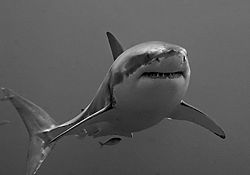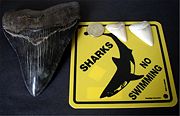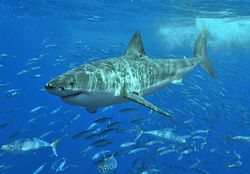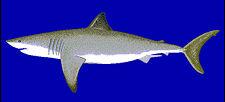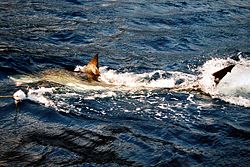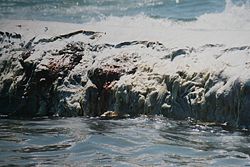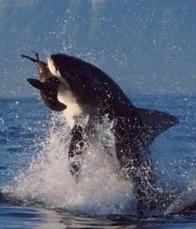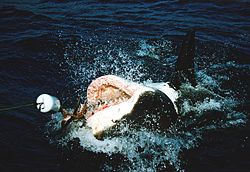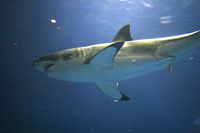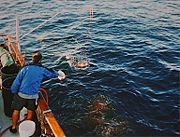Great white shark
2008/9 Schools Wikipedia Selection. Related subjects: Insects, Reptiles and Fish
|
|||||||||||||||||||||||||
The great white shark, Carcharodon carcharias, also known as white pointer, white shark, or white death, is an exceptionally large lamniform shark found in coastal surface waters in all major oceans. Reaching lengths of more than 6 m (20 ft) and weighing up to 2,250 kg (5,000 lb), the great white shark is the world's largest known predatory fish. It is the only surviving species of its genus, Carcharodon.
Taxonomy
Carolus Linnaeus gave the great white shark its first scientific name, Squalus carcharias in 1758. Sir Andrew Smith gave it the generic name Carcharodon in 1833, and in 1873 the generic name was identified with Linnaeus specific name and the current scientific name Carcharodon carcharias was finalised. Carcharodon comes from the Greek words karcharos, which means sharp or jagged, and odous, which means tooth.
Related species
The great white is classified as a mackerel ( Lamnidae) shark. There are four other living species in this family, two mako and two Lamna sharks.
Dental features and the extreme size of both the great white and the prehistoric Megalodon lead many scientists to believe they were closely related, and the name Carcharodon megalodon was applied to the latter. At present there is considerable doubt about this hypothesis, as many scientists would place the megalodon and white shark as distant relatives - sharing the family Lamnidae but no closer relationship. Latest research suggests that the great white shark is more closely related to the mako shark than to the megalodon. According to this theory, the extinct broad tooth mako, Isurus hastalis, is considered to be the true ancestor of the great white, while the megalodon has strong ties with the sharks belonging to Carcharocles genus. In this case, Otodus obliquus is considered to be the ancient representative of the extinct Carcharocles lineage; indeed, Carcharocles megalodon is a popular alternative classification of the megalodon.
Distribution and habitat
Great white sharks live in almost all coastal and offshore waters which have a water temperature of between 12 and 24° C (54° to 75° F), with greater concentrations off the southern coasts of Australia, off South Africa, California, Mexico's Isla Guadalupe and to a degree in the Central Mediterranean and Adriatic Seas. One of the densest known populations is found around Dyer Island, South Africa where much research on the shark is conducted. It can be also found in tropical waters like those of the Caribbean, and has been recorded off Mauritius. It is an epipelagic fish, but recorded or observed mostly in coastal waters in the presence of rich game like fur seals, sea lions, cetaceans, other sharks and large bony fish species. It is considered an open-ocean dweller and is recorded from the surface down to depths of 1,280 m (4,200 ft), but is most often found close to the surface.
In a recent study great white sharks from California were shown to migrate to an area between Baja California and Hawaii, where they spend at least 100 days of the year before they migrate back to Baja. On the journey out, they swim slowly and dive down to around 900 m (3,000 ft). After they arrive, they change behaviour and do short dives to about 300 m (980 ft) for up to 10 minutes. It is still unknown why they migrate and what they do there; it might be seasonal feeding or possibly a mating area.
In a similar study a great white shark from South Africa was tracked swimming to the northwestern coast of Australia and back to the same location in South Africa, a journey of 20,000 km (12,000 mi) in under 9 months.
Anatomy and appearance
The great white shark has a robust large conical-shaped snout. It has almost the same size upper and lower lobes on the tail fin (like most mackerel sharks, but unlike most other sharks).
Great white sharks display countershading, having a white underside and a grey dorsal area (sometimes in a brown or blue shade) that gives an overall "mottled" appearance. The colouration makes it difficult for prey to spot the shark because it breaks up the shark's outline when seen from a lateral perspective. When viewed from above, the darker shade blends in with the sea and when seen from below casts a minimal silhouette against the sunlight.
Great white sharks, like many other sharks, have rows of teeth behind the main ones, allowing any that break off to be rapidly replaced. A great white shark's teeth are serrated and when the shark bites it will shake its head side to side and the teeth will act as a saw and tear off large chunks of flesh. Great white sharks often swallow their own broken off teeth along with chunks of their prey's flesh.
Size
A typical adult great white shark measures 4 to 4.8 m (13 to 16 ft) with a typical weight of 680 to 1,100 kg (1,500 to 2,450 lb), females generally being larger than males. The maximum size of the great white shark has been subject to much debate, conjecture, and misinformation. Richard Ellis and John E. McCosker, both academic shark experts, devote a full chapter in their book, The Great White Shark (1991), to analysing various accounts of extreme size.
Today, most experts contend that the great white shark's "normal" maximum size is about 6 m (20 ft), with a "normal" maximum weight of about 1,900 kg (4,200 lb).
For several decades, many ichthyological works, as well as the Guinness Book of World Records, listed two great white sharks as the largest individuals caught: an 11 m (36 ft) great white captured in Southern Australian waters near Port Fairy in the 1870s, and an 11.3 m (37 ft) shark trapped in a herring weir in New Brunswick, Canada in the 1930s. While this was the commonly accepted maximum size, reports of 7.5 to 10 metre (25 to 33.3 ft) great white sharks were common and often deemed credible.
Some researchers questioned the reliability of both measurements, noting they were much larger than any other accurately-reported great white shark. The New Brunswick shark may have been a misidentified basking shark, as both sharks have similar body shapes. The question of the Port Fairy shark was settled in the 1970s, when J.E. Reynolds examined the shark's jaws and "found that the Port Fairy shark was of the order of 5 m (17 ft) in length and suggested that a mistake had been made in the original record, in 1870, of the shark's length.
Ellis and McCosker write that "the largest White Sharks accurately measured range between 19 and 21 ft (6.4 m) [about 5.8 to 6.4 m], and there are some questionable 23-footers [about 7 m] in the popular — but not the scientific — literature". Furthermore, they add that "these giants seem to disappear when a responsible observer approaches with a tape measure." (For more about legendary exaggerated shark measurements, see the submarine).
The largest specimen Ellis and McCosker endorse as reliably measured was 6.4 m (21 ft) long, caught in Cuban waters in 1945; though confident in their opinion, Ellis and McCosker note other experts have argued this individual might have been a few feet shorter. There have since been claims of larger great white sharks, but, as Ellis and McCosker note, verification is often lacking and these extraordinarily large great white sharks have, upon examination, all proved under the 20-21 ft limit. For example, a much-publicized female great white said to be 7.13 m (23.4 ft) was fished in Malta in 1987 by Alfredo Cutajar. In their book, Ellis and McCosker agree this shark seemed to be larger than average, but they did not endorse the 7.13 m (23.4 ft) measurement. In the years since, experts eventually found reason to doubt the claim, due in no small part to conflicting accounts offered by Cutajar and others. A BBC photo analyst concluded that even "allowing for error ... the shark is concluded to be in the 18.3 ft (5.6 m) range and in no way approaches the 23 ft (7.0 m) reported by Abela." (as in original)
According to the Canadian Shark Research Centre, the largest accurately measured great white shark was a female caught in August 1988 at Prince Edward Island off the Canadian (North Atlantic) coast and measured 6.1 m (20 ft). The shark was caught by David McKendrick, a local resident from Alberton, West Prince.
The question of maximum weight is complicated by the unresolved question of whether or not to account for the weight of a shark's recent meals when weighing the shark itself. With a single bite, a great white can take in up to 14 kg (31 lb) of flesh, and can gorge on several hundred kilograms or pounds of food.
Ellis and McCosker write in regards to modern great white sharks that "it is likely that [Great White] sharks can weigh as much as 2 tons", but also note that the largest recent scientifically measured examples weigh in at about 2 tonnes (1.75 short tons).
The largest great white shark recognized by the International Game Fish Association (IGFA) is one landed by Alf Dean in south Australian waters in 1959, weighing 1,208 kg (2,660 lb). Several larger great white sharks caught by anglers have since been verified, but were later disallowed from formal recognition by IGFA monitors for rules violations.
Adaptations
Great white sharks, like all other sharks, have an extra sense given by the Ampullae of Lorenzini, which enables them to detect the electromagnetic field emitted by the movement of living animals. Every time a living creature moves it generates an electrical field and great whites are so sensitive they can detect half a billionth of a volt. Most fish have a less developed but similar ability in the horizontal line along their body.
To more successfully hunt fast moving and agile prey such as sea lions, the poikilothermic great white shark has developed adaptations that allow it to maintain a body temperature warmer than the surrounding water. One of these adaptations is a " rete mirabile" (Latin for "wonderful net"). This close web-like structure of veins and arteries, located along each lateral side of the shark, conserves heat by warming the cooler arterial blood with the venous blood that has been warmed by the working muscles. This keeps certain parts of the body (particularly the brain) at temperatures up to 14 °C above the surrounding water, while the heart and gills remain at sea-temperature. When conserving energy (a great white shark can go weeks between meals), the core body temperature can drop to match the surroundings. A great white shark's success in raising its core temperature is an example of gigantothermy. Therefore, the great white shark can be considered an endothermic poikilotherm, because its body temperature is not constant but is internally regulated.
Diet and hunting
Great white sharks are carnivorous, and primarily eat fish (including rays, tuna, and smaller sharks), dolphins, porpoises, whale carcasses and pinnipeds such as seals, fur seals and sea lions and sometimes sea turtles. Sea otters and penguins are attacked at times although rarely, if ever, eaten. Great whites have also been known to eat objects that they are unable to digest. In great white sharks above 3.41 m (11 ft, 2 in) a diet consisting of a higher proportion of mammals has been observed. These sharks prefer prey with high contents of energy-rich fat. Shark expert Peter Klimley used a rod-and-reel rig and trolled carcasses of a seal, a pig, and a sheep to his boat in the South Farallons. The sharks attacked all three baits but rejected the lower fat content sheep carcass.
The great white is regarded as an apex predator with its only real threats from humans and, in at least one incident, the orca. Pods of dolphins can kill a great white shark through mobbing behaviour in which the dolphins ram the shark. Although their diets overlap greatly, there are few reports of encounters between orcas and great whites, and they do not seem to directly compete with each other. Great whites are also sometimes preyed on by larger specimens.
A great white shark primarily uses its extra senses (i.e, electrosense and mechanosense) to locate prey from far off. Then, the shark uses smell and hearing to further verify that its target is food. At close range, the shark utilizes sight for the attack.
Great white sharks' reputation as ferocious predators is well-earned, yet they are not (as was once believed) indiscriminate "eating machines". They typically hunt using an "ambush" technique, taking their prey by surprise from below. Near the now-famous Seal Island, in South Africa's False Bay; studies have shown that the shark attacks most often occur in the morning, within 2 hours after sunrise. The reason for this is that it is hard to see a shark close to the bottom at this time. The success rate of attacks is 55% in the first 2 hours, it falls to 40% in late morning and after that the sharks stop hunting.
The hunting technique of the white shark varies with the species it hunts. When hunting Cape fur seals off Seal Island, South Africa, the shark will ambush it from below at high speeds and hit the seal at mid-body. They go so fast that they actually breach out of the water. They have also been observed chasing their prey after a missed attack. The prey is usually attacked at the surface.
When hunting Northern elephant seals off California, the shark immobilizes the prey with a large bite to the hindquarters (which is the main source of the seal's mobility) and waits for the seal to bleed to death. This technique is especially used on adults which are large and dangerous. Prey is normally attacked sub-surface. Harbour seals are simply grabbed from the surface and pulled down until they stop struggling. They are then eaten near the bottom. California sea lions are ambushed from below and struck in mid-body before being dragged and eaten.
When hunting dolphins and porpoises, white sharks attack them from above, behind or below to avoid being detected by their echolocation. Among the species targeted are dusky dolphins, harbour porpoises, Risso's dolphins and Dall's porpoises.
A new study from the University of New South Wales in Sydney, Australia, is using CT scans of a shark's skull and complex computer models to measure the maximum bite force of the great white. The study will reveal what forces and behaviours the carnivore's skull is adapted to handle and will help resolve competing theories about its feeding behaviour.
Behaviour
The behaviour and social structure of the white shark is not well understood but recent research shows that white sharks are more social than previously thought. In South Africa, white sharks seem to have a dominance hierarchy depending on size, sex and squatter's rights. Females dominate over males, larger sharks dominate smaller sharks, and residents dominate newcomers. When hunting, the white sharks tend to space out between each other and resolve conflicts with rituals and displays. White sharks rarely resort to combat although some individuals have been found with bite marks that match that of other white sharks. This suggests that when their personal space is intruded upon, a white shark will give the intruder a warning bite. Another possibility is that white sharks may softly bite other individuals as a way of showing their dominance. Also, as noted above, white sharks can be cannibalistic.
The great white shark is one of only a few sharks known to regularly lift its head above the sea surface to gaze at other objects such as prey; this is known as " spy-hopping". This behaviour has also been seen in at least one group of blacktip reef sharks, but this might be a behaviour learned from interaction with humans (it is theorized that the shark may also be able to smell better this way, because smells travel through air faster than through water). They are very curious animals, and can display a high degree of intelligence and personality when conditions permit (such as in the clear waters off of Isla Guadalupe, Mexico).
Reproduction
There is still a great deal that is unknown about great white shark behaviour, such as their mating habits. Birth has never been observed, but several pregnant females have been examined. Great white sharks are ovoviviparous, the eggs developing in the female's uterus, hatching there and continuing to develop until they are born. The great white has an 11 month gestation period, with the sharks powerful jaws beginning to develop in the 1st month. The natural predatory phenomenon is known as intrauterine-cannibalism and is known to occur in several other species of shark as well. After 10 months only 1 great white is born from what can number up to 40 for a single delivery. The delivery takes place in the period transitioning spring and summer. When giving birth, the female has to fast to prevent herself from eating her young after they are born.
Almost nothing, however, is known about how and where the great white mates. There is some evidence that points to the near-soporific effect resulting from a large feast (such as a whale carcass) possibly inducing mating.
Great White Sharks take around 15 years to reach sexual maturity. The lifespan of the great white has not been definitively established, although many sources estimate that great whites live 30 to over 100 years. It would not be unreasonable to expect such a slow maturing animal to live longer than other, faster maturing varieties.
Relationship with humans
Shark attacks
More than any documented attack, Steven Spielberg's 1975 film Jaws provided the great white shark with the image of a "man eater" in the public mind. While great white sharks have been responsible for fatalities in humans, they typically do not target humans as prey: for example, in the Mediterranean Sea there were 31 confirmed attacks against humans in the last two centuries, only a small number of them deadly. Many incidents seem to be caused by the animals "test-biting" out of curiosity. Great white sharks are known to perform test-biting with buoys, flotsam, and other unfamiliar objects as well, and might grab a human or a surfboard with their mouth in order to determine what kind of object it might be.
Other incidents seem to be cases of mistaken identity, in which a shark ambushes a bather or surfer, usually from below, believing the silhouette it sees on the surface is a seal. Many attacks occur in waters with low visibility, or other situations in which the shark's senses are impaired. It has been speculated that the species typically does not like the taste of humans, or at least that the taste is unfamiliar.
However some researchers have hypothesized that the reason the proportion of fatalities is low is not because sharks do not like human flesh, but because humans are often able to get out of the water after the shark's first bite. In the 1980s John McCosker noted that divers who dived solo and were attacked by great whites were generally at least partially consumed, while divers who followed the buddy system were normally pulled out of the water by their colleagues before the shark could finish its attack. Tricas and McCosker suggest that a standard attack modus operandi for great whites is to make an initial devastating attack on its prey, and then wait for the prey to weaken before going in to consume the wounded animal. A human's ability to get to land (or onto a boat) with the help of others is unusual for a great white's prey, and thus the attack is foiled.
Humans, in any case, are not healthy for great white sharks to eat because the sharks' digestion is too slow to cope with the human body's high ratio of bone to muscle and fat. Accordingly, in most recorded attacks, great whites have broken off contact after the first bite. Fatalities are usually caused by loss of blood from the initial limb injury rather than from critical organ loss or from whole consumption.
Biologist Douglas Long writes that the great white shark's "role as a menace is exaggerated; more people are killed in the U.S. each year by dogs than have been killed by great white sharks in the last 100 years." However, such comments should be taken in context; interaction between humans and canines takes place far more regularly and in greater numbers than it does between humans and sharks.
Many "shark repellents" have been tested, some using scent, others using protective clothing, but to date the most effective is an electronic beacon ( POD) worn by the diver/surfer that creates an electric field which disturbs the shark's sensitive electro-receptive sense organs, the ampullae of Lorenzini.
Attacks on boats
Great white sharks infrequently attack and sometimes even sink boats. In a few cases they have attacked boats up to 10 meters in length. They have bumped or knocked people overboard, usually 'attacking' the boat from the stern. In one case (in 1936), a large shark leapt completely into the South African fishing boat Lucky Jim, knocking a crewman into the sea. Tricas and McCosker's underwater observations suggest that sharks are attracted to boats due to the electrical fields they generate.
Great white sharks in captivity
All attempts to keep a great white shark in captivity prior to August 1981 lasted 16 days at SeaWorld San Diego before being released into the wild.
In 1984, shortly before opening day, the Monterey Bay Aquarium in Monterey, California housed its first great white shark, which died after 10 days. In July 2003, Monterey researchers captured a small female and kept it in a large, netted pen off Malibu for five days, where they had the rare success of getting the shark to feed in captivity before it was released. It was not until September 2004 that the aquarium was the first to place a great white on long-term exhibit. The young female, who was caught off the coast of Ventura, was kept in the aquarium's massive 3,800,000 litres (1 million-gallon) Outer Bay exhibit for 198 days before her successful release back to the wild in March 2005. She was tracked for 30 days after her early morning release. On the evening of August 31, 2006 the aquarium introduced a second shark to the Outer Bay exhibit. The juvenile male, caught outside Santa Monica Bay on August 17, had its first official meal in captivity (a large salmon steak) on September 8, 2006 and as of that date, the shark was estimated to be 1.72 m (5 ft 8 in) and to weigh approximately 47 kg (104 lb). He was released on January 16, 2007 after 137 days in captivity.
Probably the most famous great white shark to be kept in captivity was a female named "Sandy", which in August 1980 became the first and only great white shark to be housed at the Steinhart Aquarium in San Francisco, California. She was returned to the wild because she would not eat anything given to her and constantly bumped against the walls.
Shark tourism and cage diving
Shark cage-diving is when a group of tourists, or those who wish to study the sharks up close are lowered into the water beside a boat, protected by a steel cage. From this view point it is easier to view the sharks up close without the dangers of being bitten. Cage diving is most common off the coasts of Australia, South Africa, and Guadalupe Island off the coast of Baja California as these are places where great white sharks are most likely to be seen.
Viewing sharks from the safety of a cage gives tourists an adrenaline rush and has become a booming industry. A common practice is to chum the water to draw in sharks for the tourists to view. These practices have raised the fear that sharks may be becoming more accustomed to people in their environment and beginning to associate human activity with food - a potentially dangerous situation. It is claimed that certain methods of chumming, such as when bait on a wire is drawn towards the divers in the cage, which may result in the shark striking the cage, exacerbate this problem. Other operators purposefully draw the bait away from the cage causing the shark to swim past the divers.
Companies respond that they are being made the scapegoats, as people try to find someone to blame for shark attacks on humans. Most point out that lightning tends to strike humans more often than sharks bite humans. Their position is that further research needs to be done before banning practices such as chumming which are said to alter sharks' natural behaviour.
It has been advised that all dive boats should only use chum in areas in which Whites are known to actively patrol anyway, and these should be far enough away from human leisure areas so as not to draw the sharks towards them. Also, responsible dive operators will not feed the sharks; only sharks that are willing to scavenge will follow the chum trail, and if they find no food at the end then the shark will soon swim off and not associate chum with a meal. It has been suggested that government licensing strategies may help enforce these suggested advisories.
The shark tourist industry has some financial leverage in conserving this animal. For a fisherman with limited income, a single set of White jaws can fetch up to £20,000, a very substantial amount of money for a day's fishing. However, the value of the dead animal is a fraction of the value of viewing a live shark, which can become a more viable and sustainable economic activity to the local community. For example, the dive industry in Gaansbai South Africa, consists of about six boat operators with each boat taking around 30 people out to sea a day; if each person pays anywhere between £50 to £150, then in a single day a solitary live shark that visits each boat can create anywhere between £9,000 to £27,000 of revenue daily.
Conservation status
It is unclear how much a concurrent increase in fishing for great white sharks had to do with the decline of great white shark population from the 1970s to the present. No accurate numbers on population are available, but populations have clearly declined to a point at which the great white shark is now considered endangered. Their reproduction is slow, with sexual maturity occurring at about 12-15 years of age, the population, therefore, can take a long time to rise.
The Convention on International Trade in Endangered Species (C.I.T.E.S.) has put the great white shark on its 'Appendix II' list of endangered species. The shark is targeted by fishermen for its jaws, teeth, and fins, and as a game fish. The great white shark, however, is rarely an object of commercial fishing, although its flesh is considered valuable. If casually captured (it happens for example in some tonnare in the Mediterranean), it is sold as smooth-hound shark.
From April 2007 great white sharks are fully protected within 200 nautical miles (370 km) of New Zealand and additionally from fishing by New Zealand-flagged boats outside this range.
